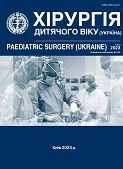Treatment and prevention of adhesive intestinal obstruction in children
DOI:
https://doi.org/10.15574/PS.2023.81.43Keywords:
adhesive intestinal obstruction, treatment, primary prevention, secondary prevention, barrier antiadhesive agents, childrenAbstract
Despite the achievements of modern pediatric surgery, to date there is no single comprehensive approach to the treatment and prevention of adhesive intestinal obstruction (AIO), both primary (prevention of adhesions formation after primary surgery) and secondary (prevention of recurrence).
Purpose - to study the clinical effectiveness of treatment, primary and secondary prevention of postoperative intestinal adhesive obstruction in children.
Materials and methods. An examination and analysis of medical records of 119 children aged 5 months to 17 years who were treated at the Pediatric Surgery Clinic of Ivano-Frankivsk National Medical University over the past 10 years for post-operative AIO was carried out. In 35 (29.41%) children a positive effect was achieved from conservative treatment. The remaining 84 (70.59%) children were operated on.
Two groups of patients were formed: the comparison group - 38 (45.24%) children, who received traditional treatment, and the main group - 46 (54.76%) children, who were intraoperatively applied anti-adhesive gel to prevent recurrence of postoperative AIO.
Results. It was established that postoperative AIO occurred in only 1 (1.19%) child after laparoscopic intervention, in the rest of the children primary surgical interventions were performed by an open method. In the comparative assessment of the postoperative course in two groups of patients, we drew attention to a more favorable course in the children of the main group, which was manifested by a faster recovery of peristalsis, a decrease in the duration of gastric stasis, a faster appearance of independent defecation, and a shorter period of inpatient treatment. When comparing the results of treatment between groups of patients, it was established that the frequency of recurrences of AIO in the main group of patients was 5.44 times lower than in children of the comparison group, and the frequency of relaparotomy for recurrent AIO was 7.28 times lower than in patients of comparison group. We did not observe complications associated with the use of anti-adhesive gel. We did not notice a significant difference in the results of treatment between patients who were treated with anti-adhesive gel of different composition (based on carboxymethylcellulose and sodium hyaluronate).
Conclusions. The most effective method of primary prevention of postoperative adhesive intestinal obstruction is the use of laparoscopic primary surgical interventions. Intraoperative application of anti-adhesive gel is a highly effective and safe recurrence prevention method of adhesive intestinal obstruction in children.
The research was carried out in accordance with the principles of the Helsinki Declaration. The study protocol was approved by the Local Ethics Committee of the participating institution. The informed consent of the patient was obtained for conducting the studies.
No conflict of interests was declared by the authors.
References
Brochhausen C, Schmitt VH, Hollemann D et al. (2012). Current strategies and future perspectives for intraperitoneal adhesion prevention. J. Gastrointest. Surg. 16: 1256-1274. https://doi.org/10.1007/s11605-011-1819-9; PMid:22297658
Deng Y, Wang Y, Guo C. (2019). Prediction of surgical management for operated adhesive postoperative small bowel obstruction in a pediatric population. Medicine (Baltimore) [Internet]. 98 (11): e14919. URL: https://www.ncbi.nlm.nih.gov/pmc/articles/PMC6426593/. https://doi.org/10.1097/MD.0000000000014919; PMid:30882714 PMCid:PMC6426593
Fofanov OD et al. (2016). Modern methods of prevention of recurrence of sebaceous intestinal obstruction in children. Galician Medical Herald. 23; 3 (3): 82-85. https://doi.org/10.21802/gmj.2016.3.23
Fredriksson F, Christofferson RH, Lilja HE. (2016). Adhesive small bowel obstruction after laparotomy during infancy. Br J Surg. 103 (3): 284-2849. https://doi.org/10.1002/bjs.10072; PMid:26667204
Melnychenko MG, Kvashnina AA. (2020). Factors predicting strangulation in children with adhesive intestinal obstruction. Neonatology, surgery and perinatal medicine. 10; 4 (38): 41-45. https://doi.org/10.24061/2413-4260.X.4.38.2020.4
Mishalov VG, Byk PL, Leshchyshyn IM and others. (2014). Effectiveness and complications of the use of anti-adhesive gel based on carboxymethylcellulose during the application of small intestinal anastomoses against the background of the adhesive process. Pediatric surgery. 1-2 (42-43): 20-27.
Nguyen ATM, Holland AJA. (2021). Paediatric adhesive bowel obstruction: a systematic review. Pediatr. Surg. Int. 37 (6): 755-763. https://doi.org/10.1007/s00383-021-04867-5; PMid:33876300
Pereyaslov AA, Dvorakevich AO, Nikyforuk OM. (2018). Laparoscopy in the treatment of children with adhesive intestinal obstruction. Pediatric surgery. Ukraine. 2: 46-50. https://doi.org/10.15574/PS.2018.59.46
Strik C, Stommel MW, Schipper LJ, Van GH, Ten Broek RP. (2016). Risk factors for future repeat abdominal surgery. Langenbeck's Arch Surg. 401 (6): 829-837. https://doi.org/10.1007/s00423-016-1414-3; PMid:27074725 PMCid:PMC5009167
Ten Broek RP et al. (2016). Epidemiology and prevention of postsurgical adhesions revisited. Ann. Surg. 263 (1): 12-19. https://doi.org/10.1097/SLA.0000000000001286; PMid:26135678
Ten Broek RPG et al. (2018). Bologna guidelines for diagnosis and management of adhesive small bowel obstruction (ASBO): 2017 update of the evidence-based guidelines from the world society of emergency surgery ASBO working group. World J. Emerg. Surg. 13; 24. https://doi.org/10.1186/s13017-018-0185-2; PMid:29946347 PMCid:PMC6006983
Vesely SV, Klimansky RP, Nguren N. (2017). Current trends in the prevention and treatment of adhesive intestinal obstruction in children (literature review). Pediatric surgery. Ukraine. 4: 46-52. https://doi.org/10.15574/PS.2017.57.46
Zeng Q, Yu Z, You J et al. (2007). Efficacy and safety of Seprafilm for preventing postoperative abdominal adhesion: systematic review and metaanalysis. World J. Surg. 31; 11: 2125-2131. https://doi.org/10.1007/s00268-007-9242-9; PMid:17899250
Downloads
Published
Issue
Section
License
Copyright (c) 2023 Paediatric Surgery (Ukraine)

This work is licensed under a Creative Commons Attribution-NonCommercial 4.0 International License.
The policy of the Journal “PAEDIATRIC SURGERY. UKRAINE” is compatible with the vast majority of funders' of open access and self-archiving policies. The journal provides immediate open access route being convinced that everyone – not only scientists - can benefit from research results, and publishes articles exclusively under open access distribution, with a Creative Commons Attribution-Noncommercial 4.0 international license(СС BY-NC).
Authors transfer the copyright to the Journal “PAEDIATRIC SURGERY.UKRAINE” when the manuscript is accepted for publication. Authors declare that this manuscript has not been published nor is under simultaneous consideration for publication elsewhere. After publication, the articles become freely available on-line to the public.
Readers have the right to use, distribute, and reproduce articles in any medium, provided the articles and the journal are properly cited.
The use of published materials for commercial purposes is strongly prohibited.

